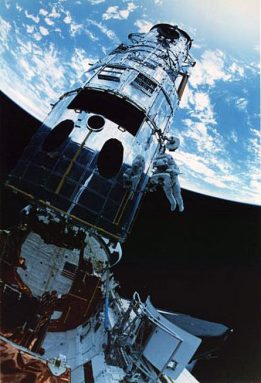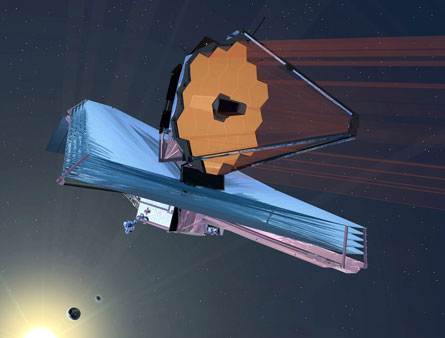Hubble Lives On
Scientists are planning the last servicing mission to one of the most important space telescopes of all time.
By Susan Gaidos
 |
|
NASA has scheduled the last servicing mission for the orbiting Hubble Space Telescope. In May, astronauts will attempt to repair instruments in an effort to keep the space craft up and running until at least 2014. |
| NASA |
It’s been a rocky past year for the Hubble Space Telescope.
The 24,500-pound spacecraft has been racing around Earth for 18 years. Over that time, it has collected a wealth of groundbreaking data. And it has revolutionized our understanding of space.
In recent months, however, technical difficulties have plagued the historic telescope. There have been electrical malfunctions, instrument failures, downed lines of communication and more.
These problems are not all that surprising, says Frank Summers, an astronomer at the Space Telescope Science Institute in Baltimore. The Hubble has already lived longer than it was originally expected to, he says. And space is a particularly harsh environment for electronic equipment.
“Big, fancy things break,” Summers says. “Those are the hazards of doing business in space.”
All is not lost, however. Many of Hubble’s instruments continue to send images and other data to scientists on Earth. Engineers on the ground have revived some of the telescope’s compromised parts. And during a servicing mission, now planned for spring of this year, astronauts will attempt to repair what can’t be fixed from here.
In the meantime, Hubble’s problems highlight how important the telescope has been to astronomy in the last two decades. Scientists have used the telescope to peer into some of the most distant galaxies in the universe. It has detected moons around planets and planets around stars. It has taught scientists about black holes and dark matter. And it has taken stunning images of colliding galaxies, exploding stars, dust storms on Mars and more.
Just in the last few months, Hubble has observed two of the most massive stars in the Milky Way, watched spots move on Jupiter and given scientists insight into how stars form.
“It is arguably the best telescope in history,” Summers says. “There are things we can do with Hubble that we can’t do with anything else. It provides us with a birds-eye view of the universe.”
Deep view
On Earth, the best place to see stars is from the top of a really tall mountain far from city lights. That’s because particles in the air, like dust, debris and smog produced by cities, absorb surrounding light. Also, our atmosphere causes light from space to bend and dim as it travels to our eyes. The effect is like looking up from the bottom of a swimming pool, says Sandra Faber, an astronomer at the University of California Observatories in Santa Cruz.
Moving closer to space removes some of this distortion. That’s why many of the world’s biggest telescopes are built on mountaintops from Chile to Hawaii to Australia.
But moving into space provides the best view of all. Scientists first started sending satellites and telescopes into space in the 1950s. The Hubble launched in 1990.
The images Hubble produced were 10 times sharper than pictures astronomers could get from the ground, Faber says. No one had seen anything like it before.
“In the early days, people would crowd around computer screens and wait with bated breath for the next image to come down,” Faber says.
Scientists have to apply to use the Hubble. When their time finally arrives, the wait is almost always worth it. Based on the mounds of data collected by Hubble over the years, researchers from around the world have published thousands of groundbreaking papers.
One of Hubble’s greatest scientific accomplishments, Faber says, is a picture called the Hubble Ultra Deep Field. To get the image, produced in 2004, the telescope collected light for a million seconds from just one region of space. The result is a picture of what the universe looked like not long after the Big Bang. (The Big Bang was a huge explosion that sparked the start of the universe about 13.7 billion years ago.)
The Hubble has also transformed the way ordinary people view astronomy. It has taken more than a hundred thousand spectacular and colorful images of galaxies, nebulae, planets and more. The gallery includes space objects that often seem too fantastic to be real.
And the Hubble is about a lot more than just pretty pictures. A variety of instruments on the telescope collect forms of light that we can’t see with our own eyes. These wavelengths reveal what stars are made of and how quickly the universe is expanding, among other types of information.
 |
|
Around 2014, NASA plans to launch the James Webb Space Telescope, shown here in an artist’s depiction. Similar but different from Hubble, the JWST will pick up where Hubble left off: hot on the trail of the universe’s most tantalizing mysteries. |
| NASA, STScl |
A long life
When scientists first designed the Hubble Space Telescope, they expected it to last for 15 years. In April, it will have its 19th anniversary. The spacecraft recently completed its 100,000th orbit around Earth.
One reason the Hubble has lasted so long is that astronauts have been able to go up and fix it when parts break. Repairs are common on ground telescopes. But the Hubble is the only space telescope that receives these kinds of visits, called servicing missions.
The first servicing mission was in 1993. During that trip, astronauts fixed a flaw in the telescope’s main mirror. They also installed and replaced a handful of instruments.
Similar missions happened in 1997, 1999 and 2002. During these visits, scientists have been able to enhance Hubble with the latest and greatest technologies.
“Each time we add new instruments, it’s like building a whole new telescope,” Summers says. “We make a brand new telescope every time.”
The latest servicing mission was originally planned for October 2008. Just two weeks before the scheduled shuttle launch, however, Hubble suddenly stopped sending data to Earth. The problem was traced to a device that formats and labels data sent to Earth. The device is supposed to collect information from the telescope’s five main instruments and send the data to scientists on Earth.
NASA engineers are prepared for problems like these. They keep a copy of the Hubble on the ground that they practice with before doing anything to the telescope in space. And they place backups of each instrument on board.
A few days after the data formatting unit shut down, scientists were able to turn on its backup. That worked, but only for a day. Then, new troubles arose, and Hubble shut down its instruments and went into a hibernating “safe mode.”
Over the next few weeks, scientists were able to turn most of the instruments back on. Hubble is now completing most if its normal operations.
One last visit
With all of the recent hiccups, the next servicing mission has been postponed until May 12, Summers says. When astronauts finally get to Hubble, they will have a small amount of time to do a lot of work. For five days, they’ll have six hours a day devoted to space walks.
During that time, astronauts plan to install two new instruments: the Wide Field Camera 3 (WFC3) and the Cosmic Origins Spectrograph (COS). They’ll try to repair two major instruments: the Advanced Camera for Surveys (ACS) and the Space Telescope Imaging Spectrograph (STIS).
And they’ll complete routine maintenance. Among other such tasks, they need to replace six 125-pound batteries and add new insulation to certain areas of the telescope.
“There is more planned for this servicing mission than for any other,” Summers says. “If all goes as planned, Hubble will be at the peak of its powers after this mission.”
No matter what happens, the next servicing mission will be Hubble’s last. Scientists hope this final round of fixes will keep the telescope ticking until at least 2014.
Around that time, NASA plans to launch the James Webb Space Telescope. Similar but different from Hubble, the JWST will pick up where Hubble left off: hot on the trail of the universe’s most tantalizing mysteries.
Going Deeper:







